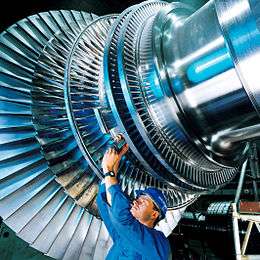Polar moment of inertia
Polar moment of inertia is a quantity used to predict an object's ability to resist torsion, in objects (or segments of objects) with an invariant circular cross section and no significant warping or out-of-plane deformation.[1] It is used to calculate the angular displacement of an object subjected to a torque. It is analogous to the area moment of inertia, which characterizes an object's ability to resist bending and is required to calculate displacement.
The larger the polar moment of area, the less the beam will twist, when subjected to a given torque.
Polar moment of area should not be confused with moment of inertia, which characterizes an object's angular acceleration due to a torque. See moment (physics).
- Note: It has become common to use "Moment of Inertia" (MOI) to refer to either or both of the planar second moment of area, , where x is the distance to some reference plane, or the polar second moment of area, , where r is the distance to some reference axis. In each case the integral is over all the infinitesimal elements of area, dA, in some two-dimensional cross-section. "Moment of Inertia" is, strictly, the second moment of mass with respect to distance from an axis: , where r is the distance to some potential rotation axis, and the integral is over all the infinitesimal elements of mass, dm, in a three-dimensional space occupied by an object. The MOI, in this sense, is the analog of mass for rotational problems.
Limitations
The polar moment of area cannot be used to analyze shafts with non-circular cross-sections. In such cases, the torsion constant can be substituted instead.
In objects with significant cross-sectional variation(along the axis of the applied torque), which cannot be analyzed in segments, a more complex approach may have to be used. See 3-D elasticity.
However the polar moment of area can be used to calculate the moment of inertia of an object with arbitrary cross-section.
Definition

- Iz = the polar moment of area about the axis z
- dA = an elemental area
- ρ = the radial distance to the element dA from the axis z
For a circular section with radius r:
Unit
The SI unit for polar moment of area, like the area moment of inertia, is metre to the fourth power (m4).
Conversion from Area Moment of Inertia
By the perpendicular axis theorem, the following equation relates Iz to the area moments of inertia about the other two mutually perpendicular axes:[2]
Application
NOTE: The following is only true for a circular or hollow circular section.
The polar moment of area appears in the formulae that describe torsional stress and angular displacement.
Torsional stress:
where is the torque, is the distance from the center and is the polar moment of area.
In a circular shaft, the shear stress is maximal at the surface of the shaft (as that is where the torque is maximal):
Most frequently the inverse problem is solved, in which one solves for the radius.
Sample calculation

Calculation of the steam turbine shaft radius for a turboset:
Assumptions:
- Power carried by the shaft is 1000 MW; this is typical for a large nuclear power plant.
- Yield stress of the steel used to make the shaft (τyield) is: 250 x 106 N/m².
- Electricity has a frequency of 50 Hz; this is the typical frequency in Europe. In North America the frequency is 60 Hz. This is assuming that there is a 1:1 correlation between rotational velocity of turbine and the frequency of mains power.
The angular frequency can be calculated with the following formula:
The torque carried by the shaft is related to the power by the following equation:
The angular frequency is therefore 314.16 rad/s and the torque 3.1831 x 106 N·m.
The maximal torque is:
After substitution of the polar moment of inertia the following expression is obtained:
The radius is 0.200 m. If one adds a factor of safety of 5 and re-calculates the radius with the maximal stress equal to the yield stress/5 the result is a radius of 0.343 m, or a diameter of 69 cm, the approximate size of a turboset shaft in a nuclear power plant.
Comparing various moments of inertias for a cylinder
Polar moment of inertia
Hollow cylinder
Moment of inertia
Solid Cylinder
Moment of inertia
where:
- is the inner diameter in m
- is the outside diameter in m
- is the moment of inertia in kg m
- is the length of cylinder in m
- is the specific mass in kg/m
See also
References
- ↑ Ugural AC, Fenster SK. Advanced Strength and Applied Elasticity. 3rd Ed. Prentice-Hall Inc. Englewood Cliffs, NJ. 1995. ISBN 0-13-137589-X.
- ↑ http://www.efunda.com/math/areas/MomentOfInertia.cfm
External links
- Torsion of Shafts - engineeringtoolbox.com
- Elastic Properties and Young Modulus for some Materials - engineeringtoolbox.com